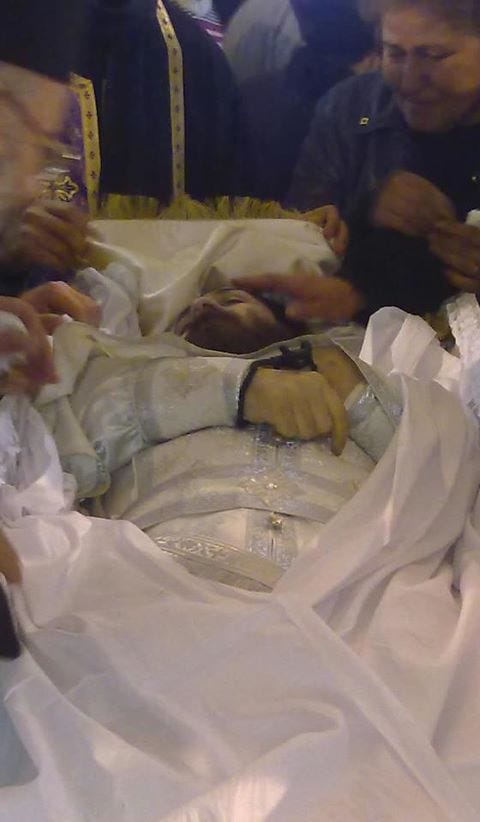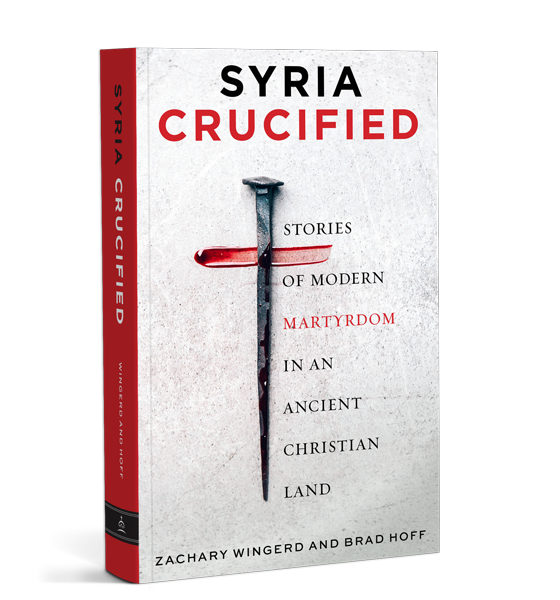In Memory of Father Basilios Nassar
The following is an excerpt titled “New Martyr of Hama” from the book written by Zachary Wingerd and Brad Hoff, Syria Crucified: Stories of Modern Martyrdom in an Ancient Christian Land (available direct through the publisher here).
---
IN 2012, EXACTLY THREE DECADES after the Hama Massacre (of 1982), the soil of Hama was once again soaked with blood as militant Islamists stormed the city from the north, hoping to capture all of Hama Province. Tragically, the first Orthodox priest to suffer martyrdom in the current war was killed during sporadic fighting in the vicinity of the Orthodox cathedral in Hama. On January 25, 2012, a young priest-monk named Fr. Basilios Nassar was informed that a member of his parish was either wounded or deceased on a sidewalk in the Jarajima neighborhood, a mere five-minute walk from archdiocesan headquarters.
Father Basilios pleaded with his spiritual father, Archbishop Elia Saliba, to allow him to tend to the injured man. At first the bishop, fearing for his safety, would not let the young priest-monk go, but Fr. Basilios finally persuaded the elder hierarch, arguing that it was his duty as a pastor, if necessary, to lay down “his life for the sheep” (John 10:11). The monk hastened toward ringing gunshots, accompanied by another priest, Fr. Panteleimon Isa.
Their progress was halted about one hundred yards from their parishioner when bystanders, cowering in corners on the street, warned them of the heavy gunfire. “We told them we were priests and proceeded,” according to the later account of Fr. Panteleimon. The pair of priests reached the man lying on the sidewalk and tried to lift him. Immediately they came under direct fire and ducked into a nearby house. Conflicting reports agreed an unknown sniper was targeting them, but both government and opposition forces later blamed each other.
The closest eyewitness to what happened next, Fr. Panteleimon, related the following details in an interview:
Father Basilios went out to look at the house. At that moment he was exposed to gunfire that entered from his right arm, penetrated his chest, and came to rest in his left arm. I rushed to his aid, and I helped him get up and go towards a nearby short wall so that we could avoid any additional injury. We started praying together while bullets were flying at us violently, from where we did not know, until he died within less than half an hour. I remained exposed to the bullets until a neighbor was able to bring me to his house. After about an hour, the regular army entered the area and we were taken to the national hospital, but Father Basilios had died about an hour or so earlier.
Father Basilios’s burial was held the next day. Thousands of mourners trailed his funeral procession through the streets of Hama.
Church and news footage inside St. George Cathedral showed teary-eyed crowds pressing up against his open casket to lovingly kiss his hands and forehead in what was clearly the burial of a new martyr. Indeed, in the days and weeks following his death, hagiographic sermons in Orthodox churches across the globe proclaimed him a hero of the Faith.

Many thousands of Syrians attended his funeral. Video of the large procession with his casket through the streets of Hama in front of the church can be found here. Regional news sources televised the service, footage of which was previously available on YouTube, but which has since been taken down. I have seen it and it is emotionally — and in a sense, spiritually — overwhelming. Young and old alike clamored to be near his body, crying and wailing as is often seen in Eastern Mediterranean cultures. But at the same time the flock is seen constantly kissing their slain shepherd’s hands in veneration. Truly it was the burial of a New Martyr, now in the presence of God.
The week after Fr. Basilios’s martyrdom, senior Antiochian clergyman Fr. Georges Massouh eulogized the Hama priest in a sermon at Balamand Seminary in Lebanon:
Basilios believed that “the servant is not greater than his Master” (John 13:16). Christ spoke these words when He washed the feet of His disciples on the night of His crucifixion. Basilios carried his apron and went around serving the poor, the destitute, the needy, the indigent, the sick, the widows, the orphans, the elderly. . . . On his final trip, he wanted to be like that Samaritan who cared for the one who had “fallen among robbers,” wounded and struggling with death. He went beyond what the Samaritan did, since it was not enough for him to give money for the wounded man’s care. He paid for redemption with his blood, to save a person from death. He died so that someone else may live and so reached the limits of martyrdom.
Fr. Basilios was pastor of Saint Elias, Kafr Buhum in Hama
It is a tragic irony that the thirty-year-old Fr. Basilios had been born in 1982, during the first round of violence centered in Hama. It drives home that in many ways the early 1980s struggle between the Assad government and the radical Islamist insurgency prefigured the current war. Despite the Church’s mission and calling as peacemaker in Syrian society, Christians continue to be targeted.
